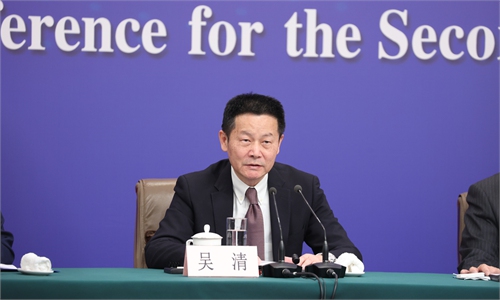
Stock market. Photo:VCG
Chinese equities edged up on Monday, with all three key indexes staging gains of more than 1 percent. The rally came amid a panic selloff sweeping across other major Asian stock markets that have been fueled by escalating geopolitical tensions in the Middle East region.
The jump came after China's State Council, the cabinet, on Friday issued a nine-point guideline - the third of its kind in history - which aims to strengthen supervision, tackle risks and promote the high-quality development of the country's capital market.
The unprecedented move signaled that the capital market is moving into a new stage of stringent supervision that prioritizes stability, according to analysts. Although it would take time to shore up investors' confidence, analysts noted that the document will lay a solid foundation for China's stock market to recover further.
The benchmark Shanghai Composite Index rose 1.26 percent to close at 3,057.38 points on Monday, while the Shenzhen Component Index gained 1.53 percent and the ChiNext Index surged 1.85 percent.
The daily turnover of the Shenzhen and Shanghai bourses reached 997.1 billion yuan ($137.73 billion) on Monday, up 187 billion yuan from Friday. The net inflow of northbound capital was 8.1 billion yuan on Monday, compared with a net outflow of 7.39 billion yuan.
In other markets outside China, Asian shares fell on Monday as investors were spooked by an escalation of the regional conflict in the Middle East. According to a Reuters report, Japan's Nikkei slid 1 percent on Monday, while Australia's S&P/ASX 200 index lost nearly 0.5 percent.
Chinese industry observers attributed Chinese equities' Monday gains to the nine-point guideline issued on Friday, which they said carries great significance in boosting investors' long-term confidence as it clearly showed how the country will build a regulated, transparent, vigorous and resilient capital market in the years to come.
"There are also hopes that the document would lead to more policies and support that could sustain a similar equities market boom like in the previous rounds," a public equity manager surnamed Zhu, based in Shenzhen, South China's Guangdong Province, told the Global Times on Monday.
The previous two nine-point guidelines on developing the capital market were issued by the State Council in 2004 and 2014, which were then followed by landmark market reforms such as stock ownership, separation reform and the registration-based stock listing system. The Shanghai Composite Index hit a historical high of more than 6,000 points in 2007, and it also exceeded 5,000 points in 2015, according to media reports.
Yang Delong, chief economist at the Shenzhen-based First Seafront Fund, told the Global Times on Monday that the main purpose of the new document issued on Friday is to address deep-seated issues that weigh on the high-quality development of the capital market.
It contains targeted measures including strict control over the quality of IPOs, strengthened regulation of listed firms, a clampdown on illicit market moves and protections for small and medium-sized investors.
"There are differences from the two previous documents, which emphasized development, improvement, a mature market and construction… The new version focuses on regulation and supervision, which are necessary to build a high-quality capital market that matches the standards of a financial powerhouse," Zhu explained.
Yang said that the new document won't spark an immediate bull run in Chinese stocks, as it will still take time for the rebound of investors' confidence after a turbulent ride in January.
Investors are also gauging clues on the Chinese economy's recovery prospects this year. "But it could restore the valuations of quality stocks and from a long-term perspective, the market could gradually embark on a path to bull conditions," Yang said.



